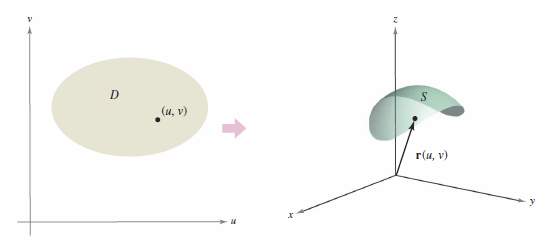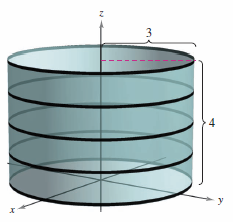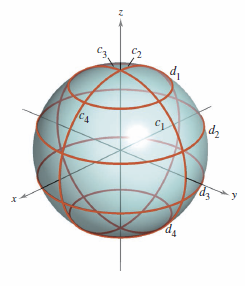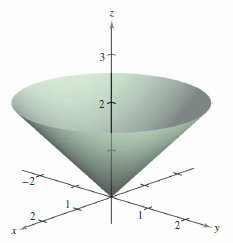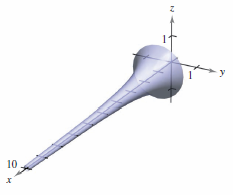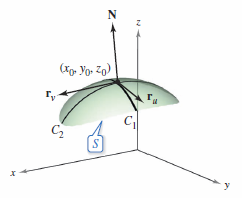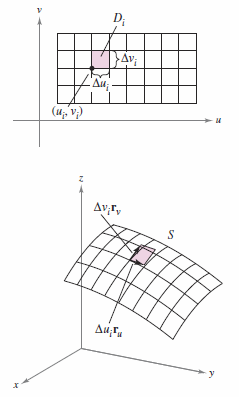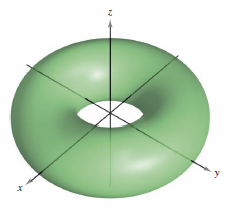Calculus III 15.05 Parametric Surfaces
| Previous | Calculus III 15.04 Green’s Theorem |
| Next | Calculus III 15.06 Surface Integrals |
Contents
15.05 Parametric Surfaces
- Parametric surface definition
- Sketch a parametric surface.
- A parametric equation set to describe a surface.
- Find a normal vector and a tangent plane to a parametric surface.
- Find the area for a parametric surface.
Parametric Surfaces
Definition 15.5.1 Parametric Surfaces
For curves, note that the vector-valued function \(\textbf{r}\) is a function with a single parameter \(t\). For surfaces, the vector-valued function is a function with two parameters \(u\) and \(v\).
Let \(x\), \(y\), and \(z\) be functions for \(u\) and \(v\) that are continuous on a domain \(D\) in the \(uv\)-plane. The point set \((x,y,z)\) given by
|
Parametric surface |
| is called a parametric surface. The equations | |
|
Parametric equations |
are the parametric equations for the surface.
If \(S\) is a parametric surface given by the vector-valued function \(\textbf{r}\), then \(S\) is traced out by the position vector \(\textbf{r}(u,v)\) as the point \((u,v)\) moves through the domain \(D\), as shown in Figure 15.5.1.
Example 15.5.1 Sketching a Parametric Surface for a Cylinder
|
|
Identify and sketch the parametric surface \(S\) given by
where \(0 \leqslant u \leqslant 2\pi\) and \(0 \leqslant v \leqslant 4\).
Each cross section for \(S\) is a circle with radius 3 and centered on the \(z\)-axis and parallel to the \(xy\)-plane. Because \(z=v\) where \(0 \leqslant v \leqslant 4\) the surface is a right circular cylinder with height 4, as shown in Figure 15.5.1. |
Example 15.5.2 Sketching a Parametric Surface for a Sphere
|
|
Identify and sketch the parametric surface \(S\) given by
where \(0 \leqslant u \leqslant \pi\) and \(0 \leqslant v \leqslant 2\pi\).
Each point on \(S\) lies on the unit sphere, centered at the origin, as shown in Figure 15.5.3. For fixed \(u=d_{i}\), \(\textbf{r}(u,v)\) traces out latitude circles
that are parallel to the \(xy\)-plane, and for fixed \(v=c_{i}\), \(\textbf{r}(u,v)\) traces out longitude, or meridian, half-circles. As proof that \(\textbf{r}(u,v)\) traces out the entire unit sphere, recall that the parametric equations
where \(0 \leqslant \theta \leqslant2\pi \) and \(0 \leqslant \phi \leqslant \pi\), describe the conversion between spherical and rectangular coordinates, as discussed in Section 11.7. |
Finding Parametric Equations for Surfaces
Examples 15.5.1 and 15.5.2 sketched a surface described by a parametric equation set. The reverse problem - deducing a parametric equation set for a given surface - is generally more difficult. For a surface type described by \(z=f(x,y)\), this problem is straightforward. The parametrized version is
- \(\textbf{r}(x,y)= x\textbf{i}+y\textbf{j}+f(x,y)\textbf{k}\).
Example 15.5.3 Representing a Surface Parametrically
|
|
Write a parametric equation set for the cone given by
as shown in Figure 15.5.4.
where \((x,y)\) varies over the entire \(xy\)-plane. |
A second surface that is easily represented parametrically is a rotated surface. For example, to represent the surface formed by revolving the graph for
- \( y=f(x) \: a \leqslant x \leqslant b\)
about the \(x\)-axis, use
- \(x=u, \: y=f(u) \cos v \text{, and } z=f(u) \sin v\)
where \(a \leqslant u \leqslant b\) and \( 0 \leqslant v \leqslant 2 \pi\).
The surface for Gabriel's Horn in Example 15.5.4 is formed by revolving the graph for \(y=f(x)\) about the \(x\)-axis. For other rotated surfaces a similar parametrization can be used. For example, to parametrize the surface formed by revolving the graph for \(x=f(z)\) about the \(z\)-axis, use
- \(z=u, \: x=f(u) \cos v \text{, and } y=f(u) \sin v.\)
Example 15.5.4 Representing a Rotated Surface Parametrically
|
|
Write a parametric equation set for the rotated surface produced by revolving
about the \(x\)-axis.
where
The resulting surface is the exterior for Gabriel's Horn, as shown in Figure 15.5.5. |
Normal Vectors and Tangent Planes
|
|
Let \(S\) be a parametric surface given by
over an open region \(D\) such that \(x\), \(y\), and \(z\) have continuous partial derivatives on \(D\). The partial derivatives for \( \textbf{r}\) with respect to \(u\) and \(v\) are defined as
and
Each partial derivative is a vector-valued function that can be interpreted geometrically in as a tangent vector. For example, if \(v=v_{0}\) is held constant, then \( \textbf{r}(u,v_{0})\) is a vector-valued function for a single parameter and defines a curve \(C_{1}\) that lies on the surface \(S\). The tangent vector to \(C_{1}\) at the point
is given by
as shown in Figure 15.5.6. Similarly, if \(u=u_{0}\) is held constant, the \(\textbf{r}(u_{0},v)\) is a vector valued function with a single parameter and defines a curve \(C_{2}\) that lies on the surface \(S\). The tangent vector to \(C_{2}\) at the point \( (x(u_{0},v_{0}), y(u_{0},v_{0}), z(u_{0},v_{0}))\) is given by
If the normal vector \(\textbf{r}_{u} \times \textbf{r}_{v} \) is not \(\textbf{0}\) for any \((u,v)\) in \(D\), then the surface \(S\) is called smooth and will have a tangent plane. Informally, a smooth surface is one that has no sharp points or cusps. For instance, spheres, ellipsoids, and paraboloids are smooth, whereas the cone given in Example 15.5.3 is not smooth. |
Definition 15.5.2 Normal Vector to a Smooth Parametric Surface
Let \(S\) be a smooth parametric surface
- \(\textbf{r}(u,v) = x(u,v)\textbf{i} +y(u,v)\textbf{j} +z(u,v)\textbf{k} \)
defined over an open region \(D\) in the \(uv\)-plane. Let \((u_{0},v_{0})\) be a point in \(D\). A normal vector at the point
- \((x_{0},y_{0},z_{0}) = (x(u_{0},v_{0}), y(u_{0},v_{0}), z(u_{0},v_{0}))\)
is given by
- $$ \textbf{N} = \textbf{r}_{u}(u_{0},v_{0}) \times \textbf{r}_{v}(u_{0},v_{0}) = \begin{vmatrix}\textbf{i} & \textbf{j} & \textbf{k} \\ \frac{\partial x}{\partial u} & \frac{\partial y}{\partial u} & \frac{\partial z}{\partial u} \\ \frac{\partial x}{\partial v} & \frac{\partial y}{\partial v} & \frac{\partial z}{\partial v} \end{vmatrix}. $$
Figure 15.5.6 shows the normal vector \( \textbf{r}_{u} \times \textbf{r}_{v}\). It is also normal to \(S\) and points in the opposite direction.
Example 15.5.5 Finding a Tangent Plane to a Parametric Surface
|
|
Find an equation for the tangent plane to the paraboloid
at the point \((1,2,5)\).
The normal vector is given by
which implies that the normal vector at \((1,2,5)\) is
The tangent plane is shown in Figure 15.5.7. |
Area for a Parametric Surface
|
|
The techniques for determining surface area described in Section 14.5 can be extended to a parametric surface. Begin by constructing an inner partition on \(D\) having \(n\) rectangles, where the \(i\)th rectangle \(D_{i}\) is \(\Delta A_{i} = \Delta u_{i} \Delta v_{i}\), as shown in Figure 15.5.8. In each \(D_{i}\), let \((u_{i},v_{i})\) be that point closest to the origin. At the point
on the surface \(S\), construct a tangent plane \(T_{i}\). The area for the rectangle that corresponds to \(D_{i}\), \(T_{i}\), can be approximated by a parallelogram in the tangent plane. As in, \(\Delta T_{i} \approx \Delta S_{i}\). The surface for \(S\) is given by \(\sum \Delta S_{i} \approx \sum \Delta T_{i}\). The area for the parallelogram in the tangent plane is
which leads to Definition 15.5.3. Definition 15.5.3 Area for a Parametric SurfaceLet \(S\) be a smooth parametric surface
defined over an open region \(D\) in the \(uv\)-plane. If each point on the surface \(S\) corresponds to exactly one point in the domain \(D\), then the surface area for \(S\) is given by
where
A surface \(S\) given by \(z=f(x,y)\) can be parametrized using the vector valued function
defined over the region \(R\) in the \(xy\)-plane. Using
produces
and
This produces the surface area for \(S\) as
|
Example 15.5.6 Surface Area for a Sphere
Find the surface area for the unit sphere
- \(\textbf{r}(u,v) = \sin u \cos v\textbf{i} + \sin u \sin v\textbf{j} + \cos u\textbf{k} \)
where the domain \(D\) is \(0 \leqslant u \leqslant \pi \) and \( 0 \leqslant v \leqslant 2 \pi\).
Solution Calculating \(\textbf{r}_{u}\) and \(\textbf{r}_{v}\) produces
| \(\textbf{r}_{u} \) | \(= \cos u \cos v\textbf{i} + \cos u \sin v\textbf{j} - \sin u\textbf{k} \) |
| \(\textbf{r}_{v} \) | \(= -\sin u \sin v\textbf{i} + \sin u \cos v\textbf{j}. \) |
Their cross produce is
| \(\textbf{r}_{u} \times \textbf{r}_{v} \) | $$= \begin{vmatrix}\textbf{i} & \textbf{j} & \textbf{k} \\ \cos u \cos v & \cos u \sin v & -\sin u\\ -\sin u \sin v & \sin u \cos v & 0\end{vmatrix}$$ |
| \(= \sin^{2}u \cos v\textbf{i} + \sin^{2} u \sin v \textbf{j} + \sin u \cos u \textbf{k} \) |
Normalizing the cross product produces
| \( \| \textbf{r}_{u} \times \textbf{r}_{v} \|\) | \(= \sqrt{(\sin^{2}u \cos v)^{2} + (\sin^{2} u \sin v)^{2} + (\sin u \cos u)^{2}}\) |
| \(= \sqrt{\sin^{4} u + \sin^{2}u \cos^{2}u }\) | |
| \(= \sqrt{\sin^{2} u }\) | |
| \(= \sin u. \:\:\:\: \color{red}{ \sin u > 0 \text{ for } 0 \leqslant u \leqslant \pi} \) |
Integrating the normalized cross product produces the sphere's surface area
| \(A\) | $$=\int_{D} \int \| \textbf{r}_{u} \times \textbf{r}_{v} \| \: dA $$ |
| $$= \int_{0}^{2\pi} \int_{0}^{\pi} \sin u \: du \: dv $$ | |
| $$= \int_{0}^{2\pi} 2 \: dv = 4 \pi.$$ |
Note: This surface does not satisfy the requirement in Definition 15.5.3 that each point on the surface corresponds to exactly one point in \(D\) because \( \textbf{r}(u,0) = \textbf{r}(u,2\pi) \) for any fixed value for \(u\). However, because the overlap is only a semicircle with no area, the definition can be applied.
Example 15.5.7 Finding the Surface area for a Torus
|
|
Find the surface area for the torus given by
where the domain \(D\) is \(0 \leqslant u \leqslant \pi \) and \( 0 \leqslant v \leqslant 2 \pi\), as shown in Figure 15.5.9.
Their cross produce is
Normalizing the cross product produces
Integrating the normalized cross product produces the sphere's surface area
|
The formula discussed in Section 7.4.3 is equivalent Definition 15.5.3. For example, suppose that \(f\) is a nonnegative function such that \(f^{\prime}\) is continuous over the interval \([a,b]\). Let \(S\) be the rotated surface formed by revolving the graph for \(f\), where \( a \leqslant x \leqslant b\), about the \(x\)-axis. The formula in Section 7.4.3 is
- $$\text{Surface area } = 2 \pi \int_{a}^{b} f(x) \sqrt{1 + [f^{\prime}(x)]^{2}}. $$
To represent \(S\) parametrically, let
- \(x=u, \: y=f(u) \cos v \text{, and } z = f(u) \sin v\)
where \(a \leqslant u \leqslant b \) and \( 0 \leqslant v \leqslant 2 \pi.\) Then,
- \(\textbf{r}(u,v) = u \textbf{i} + f(u) \cos v\textbf{j} + f( u) \sin v \textbf{k}.\)
Internal Links
Parent Article: Calculus III 15 Vector Analysis
